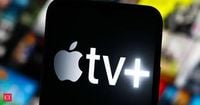Apple TV+ is once again making headlines, and not just for its Emmy-nominated dramas or blockbuster films. As of August 21, 2025, the tech giant's streaming service has hiked its monthly subscription price to $12.99 for new U.S. subscribers, a 30% jump from the previous $9.99. Existing subscribers will see the higher rate reflected within 30 days of their next renewal date, according to The Economic Times, Mashable, and Forbes. This marks the third price increase in as many years, and for some longtime users, it’s a reminder of just how much the streaming landscape has changed since Apple TV+ first entered the scene.
Back in November 2019, Apple TV+ launched at a modest $4.99 per month—a bargain compared to its competitors. That initial price point was part of Apple’s strategy to attract viewers to a service that, at the time, offered a much smaller content library than the likes of Netflix or Hulu. But as Variety and Mashable both point out, those days are long gone. The first hike came in October 2022, bumping the fee up to $6.99. Another followed in October 2023, raising the price to $9.99. Now, at $12.99 per month, the cost has nearly tripled in just six years.
Apple’s justification for the latest increase? Expansion. In a statement provided to Variety, the company highlighted its "deep library of hundreds of Apple Originals, with thousands of hours of premium programming across genres and brand-new releases weekly—all ad-free." Apple TV+ has indeed grown into a destination for high-quality, original content. From smash-hit series like Ted Lasso, Severance, and The Morning Show to acclaimed films such as CODA and Killers of the Flower Moon, the streamer has racked up awards and critical praise. This year, Severance led the Emmy nominations with 27 nods, while Seth Rogen’s The Studio made history as the most-nominated freshman comedy with 23 nominations, according to Forbes and Variety.
The fall 2025 lineup is no less ambitious. Subscribers can look forward to Season 4 of The Morning Show on September 17, Season 5 of Slow Horses on September 24, Vince Gilligan’s highly anticipated new series Pluribus on November 7, and original films Highest 2 Lowest (September 5) and The Lost Bus (October 3). For families, Apple TV+ continues to offer classics like the Peanuts specials, and sports fans can catch live coverage of Major League Soccer and MLB’s "Friday Night Baseball."
Yet, the price hike comes at a time when streaming fatigue is setting in for many consumers. As Mashable notes, Apple TV+ is now more expensive than Disney+, HBO Max, Hulu, and even Netflix at the basic entry level. For context, Netflix’s ad-supported plan starts at $7.99, but its ad-free standard plan sits at $17.99 (and only offers 1080p streaming), while 4K viewing requires a hefty $24.99 per month. Apple TV+, by contrast, offers all its content in 4K at no extra charge and remains ad-free—something the company touts as a major advantage.
Still, the cumulative effect of multiple streaming subscriptions is starting to resemble the cable bills cord-cutters once sought to escape. As one Variety columnist put it, "It’s no longer cost effective to simply cut the cord and subscribe to every streaming service instead, particularly if opting for the more premium, ad-free tiers. Going that route is trading a high cable or satellite TV bill for multiple smaller ones that add up to the same or similar high monthly cost."
For budget-conscious viewers, there are still ways to save. The annual Apple TV+ subscription remains unchanged at $99 per year, which breaks down to about $8.25 per month—a 36% discount compared to monthly billing, according to Mashable. Switching to an annual plan is as simple as adjusting your settings in your Apple account. Additionally, new subscribers can claim a free 7-day trial, and the service is included for three months with the purchase of a new Apple device. Apple TV+ is also bundled with Apple One, which starts at $19.95 per month and offers a one-month free trial.
One major difference between Apple TV+ and its competitors is the absence of an ad-supported tier. While Netflix, Peacock, Disney+, and Max have all introduced lower-priced, ad-supported options in a bid to attract more cost-sensitive viewers, Apple has so far resisted that route. As Forbes observes, Apple TV+ is "the only major streaming service without an ad-supported option." Whether this will remain a selling point—or a missed opportunity—remains to be seen.
Behind the scenes, Apple is spending big to keep its streaming service competitive. The company reportedly invests over $4.5 billion a year on content, according to The Information and Forbes. Despite these investments, Apple TV+ is not yet profitable, with annual losses exceeding $1 billion. In 2024, Apple even trimmed its content budget by about $500 million, but the streamer continues to expand its reach, recently launching on Android devices—a move that could broaden its global audience.
Apple’s price hike is part of a broader trend in the streaming industry. NBCUniversal’s Peacock also raised its rates by $3 a month this year, and Netflix increased prices across its ad-supported and ad-free plans. Spotify, too, has bumped subscription fees in several markets. The rationale is familiar: as platforms vie for subscribers and awards, the cost of producing premium content continues to climb, and companies are eager to recoup those investments.
As for Apple TV+’s subscriber base, it’s estimated at around 45 million, according to Forbes. That’s a respectable figure, though still dwarfed by Netflix’s and Disney+’s global reach. Apple is banking on exclusive content and a reputation for quality over quantity to keep its audience engaged, even as the service grows more expensive.
Ultimately, whether Apple TV+ remains "worth it" is a subjective call. For some, the allure of ad-free, high-quality originals and exclusive sports coverage justifies the premium. For others, the steady march of price increases may prompt a rethink of which streaming services earn a spot in their monthly rotation. With more options—and higher costs—than ever before, viewers are left to decide what’s truly must-see TV in the age of streaming.


